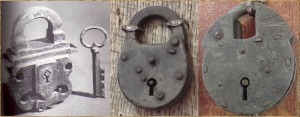Portable locks date back to the Roman Era, 500 BC – 300 AD. They have also been used to protect personal property in China since the Eastern Han Dynasty (25 – 220 AD). Early locks were made from bronze, brass, silver and other materials. Bronze was most prevalent for the early Chinese locks.
Although locks with shackles were known in early times by merchants traveling the ancient trade routes to Asia and China, the name padlock wasn’t coined until the period between 850 AD and 1000 AD in England, where key-operated locks were used to hold livestock within a paddock. The spring-tine mechanism found in a Viking settlement in York, England, was thus referred to as a pad lock.
In 1877, an American patent was granted to Yale & Towne for a padlock that housed a stack of levers and had a shackle that swung away when unlocked. It was a notable design because the levers were sub-assembled into a “cartridge” that could be slid into a cast brass body shell. The assembly would remain together by means of two taper pins passed through the shell and cartridge. This design gave the commercial padlock market a serviceable, rekeyable padlock. About twenty years later Yale made another “cartridge” style padlock that employed their famous pin tumbler mechanism and a shackle that slid out of the body instead of swinging away.
In 1921, Harry Soref founded Master Lock in Milwaukee, Wisconsin, where the company still thrives. Soref invented and patented the world’s first laminated padlock in 1924, after noting that bank vault doors and battle ships were built in laminated layers of steel for greater strength.
Anderson Lock stocks a wide variety of sizes and types of padlocks. One of the newer designs is the Master Lock ProSeries Resettable Combination Padlock, created for commercial/industrial applications. It features a 2-1/4″ wide, solid-brass body for superior corrosion resistance, and a 1-1/16″ tall, 3/8″ diameter octagonal boron-carbide shackle, for ultimate cut resistance. A set-your-own combination feature offers convenience and security with 10,000 possible combinations – no reset tool required – and a deadlocking mechanism protects against prying, shimming and rap attacks.





